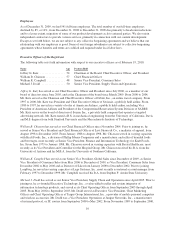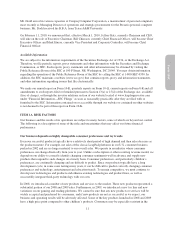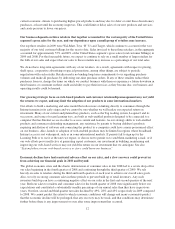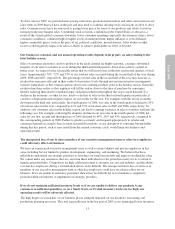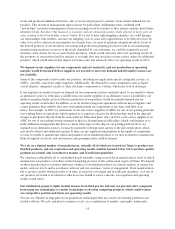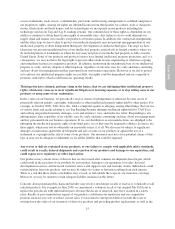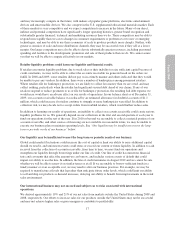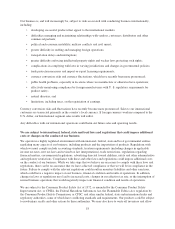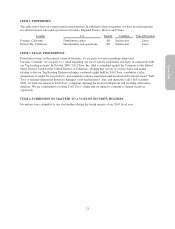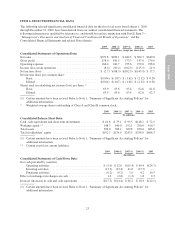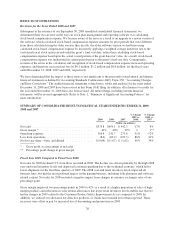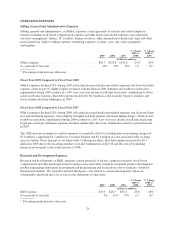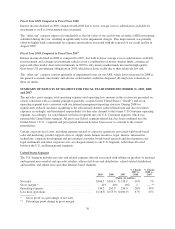LeapFrog 2009 Annual Report Download - page 30
Download and view the complete annual report
Please find page 30 of the 2009 LeapFrog annual report below. You can navigate through the pages in the report by either clicking on the pages listed below, or by using the keyword search tool below to find specific information within the annual report.• any determinations with respect to mergers, other business combinations, or changes in control;
• our acquisition or disposition of assets;
• our financing activities; and
• payment of dividends on our capital stock, subject to the limitations imposed by our credit facility.
For example, at our last Annual Meeting of Stockholders, an entity controlled by Mr. Ellison introduced
proposals to amend our Amended and Restated Bylaws to allow stockholders to fill Board vacancies and to
provide that we will not be governed by Section 203 of the Delaware General Corporation Law, which imposes
restrictions upon business combinations and specified other transactions between us and any “interested
stockholder” (generally, a holder of shares representing 15% or more of our outstanding voting power). Our
Board of Directors did not solicit proxies for or against these proposals, nor did the Board make any
recommendation for or against the proposals. Both of these proposals were adopted.
In addition, two of our directors, Philip B. Simon and Paul T. Marinelli, are President and Vice President,
respectively, of Lawrence Investments, LLC, an entity also controlled by Mr. Ellison.
Mr. Ellison could have interests that diverge from those of our other stockholders. This control by Mr. Ellison
could depress the market price of our Class A common stock; deter, delay or prevent a change in control of
LeapFrog; or affect other significant corporate transactions that otherwise might be viewed as beneficial for other
stockholders.
Our stock price has been extremely volatile over the past several years and could decline in the future,
resulting in losses for our investors and harming the employee-retention and recruiting value of our equity
compensation.
Our stock price has been extremely volatile since the markets began suffering rapid declines in stock prices,
particularly since the third quarter of 2008. Our closing stock price on the New York Stock Exchange declined to
$1.14 during the first quarter of 2009, down from a high in 2008 of $10.63 during the third quarter, and, as of
February 19, 2010, our closing stock price was $5.15. All the factors discussed in this section could affect our
stock price. The timing of announcements in the public markets regarding new products, product enhancements
or product recalls by us or our competitors, or any other material announcements could affect our stock price.
Speculation in the media and analyst communities, changes in recommendations or earnings estimates by
financial analysts, changes in investors’ or analysts’ valuation measures for our stock and market trends unrelated
to our stock can cause the price of our stock to change. A significant drop in the price of our stock could also
expose us to the risk of securities class action lawsuits, which could result in substantial costs and divert
management’s attention and resources, adversely affecting our business.
Our future success depends partly on the continued contribution of our key executives and technical, sales,
marketing, manufacturing and administrative personnel. Part of our compensation package includes stock and/or
stock options. To the extent our stock performs poorly, it may adversely affect our ability to retain or attract key
employees, potentially resulting in lost institutional knowledge and key talent. Changes in compensation
packages or costs could impact our profitability and/or our ability to attract and retain sufficient qualified
personnel.
ITEM 1B. UNRESOLVED STAFF COMMENTS
Not Applicable.
20


